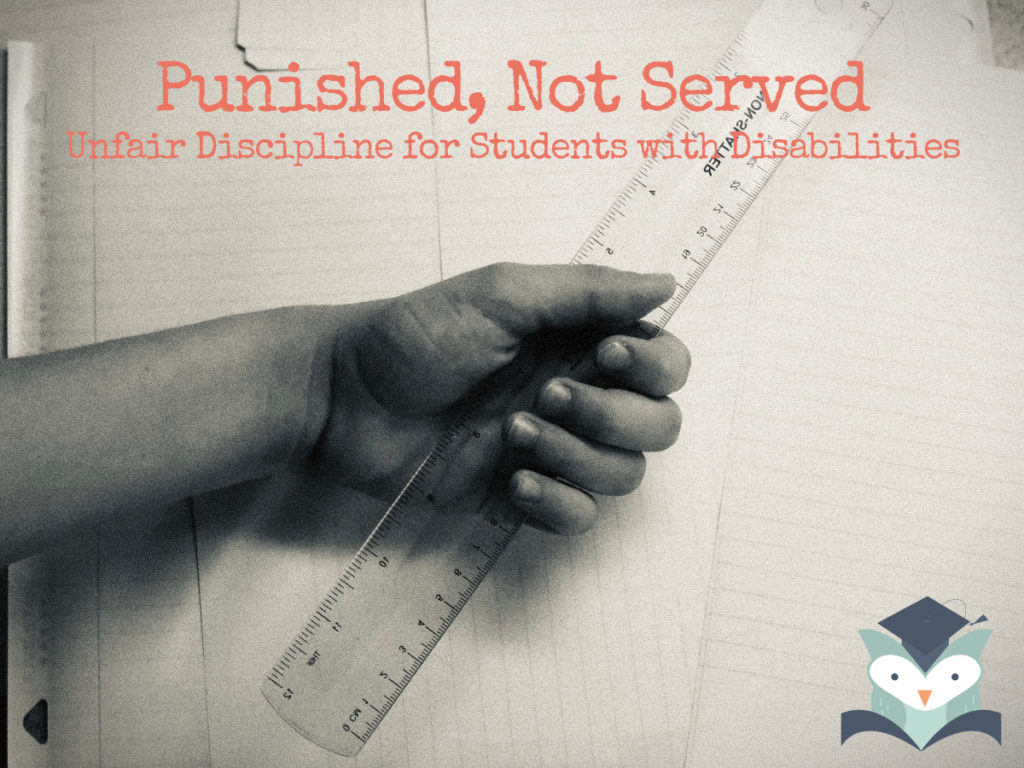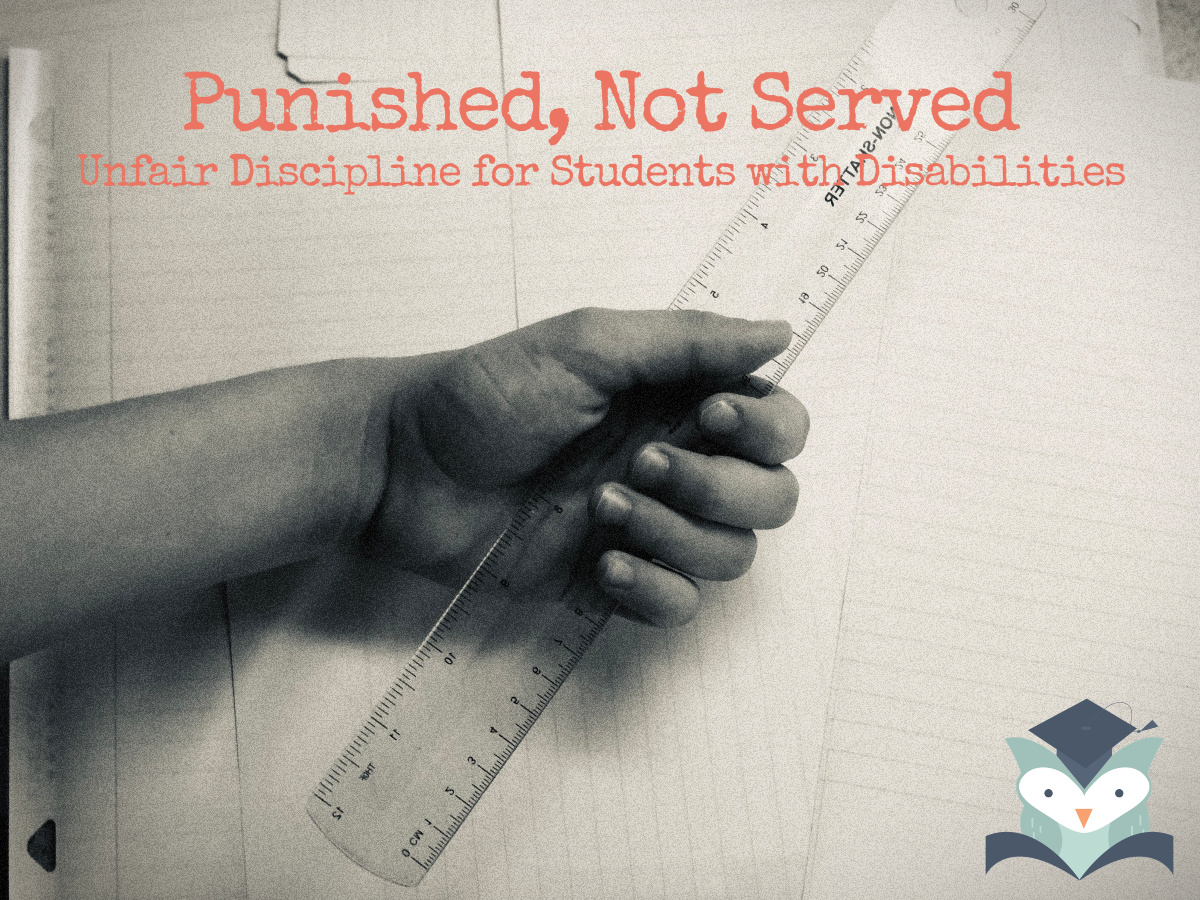Editor’s note: We are featuring the work of guest blogger Bekah McNeel, who writes on our site as Hall Monitor, in a four-part investigative series entitled Punished, Not Served: Unfair Discipline for Students with Disabilities. This is Part II.

In this installment of Punished, Not Served, we look at why students are being disciplined. What are the behaviors landing them in the principal’s office and sent out the door? The way rules are written has an effect on how students with special needs are treated within the school community.
What if sneezing could land you in alternative school?
Sneezes are loud. They are disruptive. They endanger others through the spray of germs.
However, living in central Texas, we know that sneezes are involuntary and punishing kids with allergies would be cruel and counterproductive.
But what if, instead of allergies, a child has a disability—one that makes them unable to follow complex directions, or unable to sit still for long periods of time.
Unlike sneezing, those often involuntary actions are grounds for suspension, expulsion, and assignment to alternative school. But it’s often difficult to appeal a disciplinary action, given the haphazard way incidents are reported.
“Often times the incident report itself is pretty much just a generic form,” said Jennifer Fitzhugh, the special education advocate we heard from in Part I.
Other incident reports include a detailed description, written by an eyewitness. This can be any teacher or administrator, not just those trained to understand the way disabilities affect behavior. It can also be filled out by a classroom teacher whose own frustration or failure to abide by the student’s individualized education plan (IEP) could have contributed to the escalated incident.
“I can guarantee you, when those behaviors happen, what should have been done [by the teacher] is not done,” Fitzhugh said.
Escape Hatch
Together, disrupting class, insubordination, leaving class without permission, and refusal to respond to discipline made up 70 percent of the disciplinary incidents for students receiving SPED services in San Antonio ISD in 2017–18. All of those behaviors can be manifestations of emotional disturbance.
They can also, Fitzhugh said, be strategic. Learning disability is the single most overrepresented diagnosis in the Texas discipline data, and there are likely many more who have gone undiagnosed in Texas’s years of capping SPED services. For those students, Fitzhugh explained, school is intensely frustrating, even panic-inducing. They may not understand what the teacher is asking them to do, and so they refuse to try the task. If they are not getting the support they need in class, Fitzhugh explained, many will figure out how to get out of class. If shouting profanity gets the job done, so be it.
“We want to avoid things that are difficult,” Fitzhugh explained. For some students that avoidance becomes a “snowball that picks up momentum.”
Baked In
In 2017–18 schools handed down in-school suspensions over one million times, to 487,000 students. The infraction, in at least 90 percent of those, was coded only as “violation of local code of conduct.”
For students with social, emotional, and cognitive disabilities, local codes of conduct often contain behaviors that are manifestations of their disabilities.
For instance, in the Northside ISD student code of conduct, students can be suspended if they:
- Throw objects that can cause bodily injury or damage property
- Engage in evasion or leaves school grounds or school-sponsored events without Permission
- Disrupt the school environment or educational process
- Displays flagrant or extreme insubordination
These behaviors are usually coded with reference numbers which will ultimately be used to determine grounds for suspension, expulsion, or other discipline. The subjective description written out by the eyewitness is converted into one or more of these codes. So a student who tips over his desk in frustration, or throws his book on the ground, is disciplined for “throwing classroom objects,” implying a danger to others. Pressure mounts to remove a child from class if their behavior is not merely disruptive, but perceived as dangerous.
Parent Pressure
When parents hear of classroom disruption or “danger,” things can get ugly.
In December 2018, parental outrage reached fever pitch at one school in San Antonio ISD. In response to the school’s policy of including as many SPED recipients in general education classrooms as possible and practicing restorative justice, parents took to a school-wide message board to complain about the students in their children’s classroom who received special education services. Complaints ranged from students being “disruptive” to being “violent.”
The exchange quickly grew vitriolic, with parents referring to the offending student as “Stabby McGhee,” calling for more strict discipline, and saying, plainly, “I don’t care that the child who’s being disruptive is missing out on instructional time.”
It is in this climate that teachers and administrators often make decisions about whether or not a student should remain in class, be sent to a resource room, be sent home, or expelled to an alternative school.
This series, Punished, Not Served: Unfair Discipline for Students with Disabilities, has three other installments:
- Part I: Texas Data Shows Students with Certain Disabilities Are More Likely to Be Disciplined than Served—breaking down statewide data to demonstrate how some SPED students are even less likely to be served, and more likely to be punished.
- Part III: No One Seems to Want These Kids in Class—The story of a mom who struggled to get a school to meet her son’s needs instead of just sending him home.
- Part IV: The Battleground of Toileting—When a special education plan requires the adults to assist a child with bathroom duties, there can be resistance, shame, and missed learning time.
